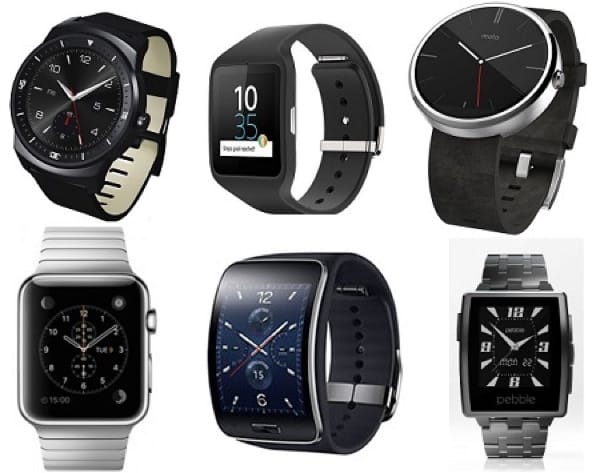Smartwatches now outsell Swiss watches...

Anyone who doubted 2015 was the year of the smartwatch will be proven wrong by figures from Strategy Analytics, which showed in the first months of the year shipments of smartwatches just beat those of Swiss swatches.
The figures reveal that smartwatches sold 8.1 a heady million units, compared with 7.9 million units for Swiss watches. That’s quite an impressive feat for the smartwatch category, which has gone from zero to hero in little over a year.
What defines a smartwatch?
The term smartwatch is a fairly broad definition and the watches included thus changes depending on whose definition you take. Of course, a watch that has features above and beyond telling the time are generally considered smartwatches.
Strategy Analytics however defines a smartwatch as “a computerized wristwatch with a high-level or expandable operating system produced and shipped from any country worldwide”.
In most cases it’s pretty obvious whether a particular watch is a smartwatch, but by way of contrast, Swiss watches are considered “a wristwatch produced and shipped from Switzerland”. Got it?!
The Apple factor
Since its official release in 2014, the Apple Watch has had quite a pronounced impact on the smartwatch industry. History repeated itself with Apple opening an existing market to a wide variety of people who would have previously had little or no interest in the device.

By anyone’s measure, Apple is currently the dominant player in smartwatches. For example, in the last quarter of 2015, Apple Watches accounted for more than 60 percent of global smartwatch shipments, with 5.1 million watches sold. However, the firm hasn’t released any official sales figures, so all statistics on the Apple Watch are estimates at best.
Strategy Analytics also hints at a small decrease in Apple’s share of the market from Q2 when the watch was initially released. At the time Apple enjoyed a commanding 75 percent share, but it’s not surprising that such a healthy lead would slowly fall post-release.
Everyone else
Aside from Apple, the other main contender in smartwatches is Samsung with around 16 percent of the market, which means with Apple they have around 80 percent in total. Not so different from the mobile phone industry then, where Samsung and Apple are pretty much major players, with everyone else struggling to catch up.
Only 20 percent of the smartwatch market then includes devices from the likes of LG, Sony, HTC, Pebble and others. For the Swiss watch industry however there’s an even more miserable statistic, that just 1 percent of the market is represented by Swiss companies. They are trying to compete however, with new devices like the Tag Heuer Connected, but unfortunately the price tag puts it out of the reach of most consumers.

It’s almost impossible to analyse the real impact that smartwatches are having on the Swiss watchmakers. The press and media have jumped on the “crisis” reportedly happening in the build up to the Apple Watch, but sales figures and interest in classic Swiss watches has still remained healthy.
To put things in perspective, the smartwatch market has grown by more than 300 percent last year, whereas Swiss watch shipments fell by 5 percent in late 2015. Perhaps the “crisis” is finally starting to have an impact, albeit a small one?
Companies like Tag might take some comfort that the people who are interested in buying one of their expensive, luxury timepieces are probably not in the market for a smartwatch (or perhaps they will buy one of each).
The future of Smartwatches
Every month there’s a raft of new smartwatches released, updates to older models, and concept demos that hint at innovative new features just around the corner.
As far as Apple is concerned, the next Apple Watch might be announced later this month, although it’s more likely to be in the autumn. That would certainly be one of the biggest launches this year however and should likely help solidify Apple’s position as the top selling smartwatch maker.
Several other companies of note are also jumping on the bandwagon, such as Casio, which is reported to be releasing the traditional-looking CSD-F10 this month. Classed as a smart outdoor watch running Android, it will be interesting to see how the new device stacks up against its rivals.

Samsung recently released the Gear 2, and will no doubt be promoting it heavily over the next few months before the Apple Watch 2 sees the light of day.
Meanwhile, Pebble has just slashed the price of its Time, making it even more affordable to buy a well designed, feature-rich smartwatch. The Time and Time Round smartwatches now cost $149.99 and $199.99 respectively.
What comes next for Swiss watches?
There’s not long to wait until the most important even in the Swiss watch industry – Baselworld 2016 on the 17th of March, at which just about every watch manufacturer from the country will be present..
As always there will be lots of new models on show at Baselworld, but we don’t expect too many new smartwatches to be revealed at the show. Stick with what you know, we say…
It’s apparent though that Swiss watch companies have been reticent to embrace the smartwatch. Neil Mawson of Strategy Analytics said recently that “The Swiss watch industry has been sticking its head in the sand and hoping smartwatches will go away…and they are a long way behind Apple, Samsung and other leaders in the high-growth smartwatch category”.
You may have heard of the quartz crisis, a reference to the rise of cheap Japanese watches that caused economic upheavals in the 1970s and early 1980s by replacing the majority of mechanical watches. It’s not yet certain whether the smartwatch revolution is another quartz crisis in the making, but no doubt there will at the very least be some interesting products at Baselworld to help stave off the threat.



